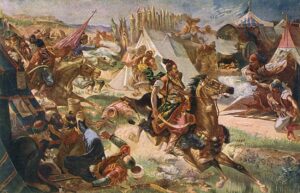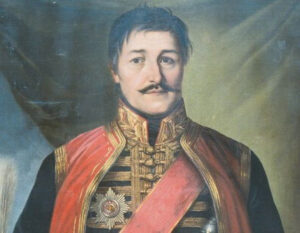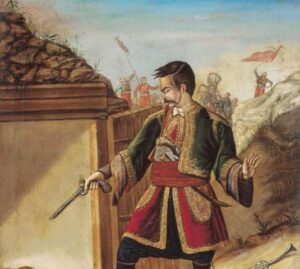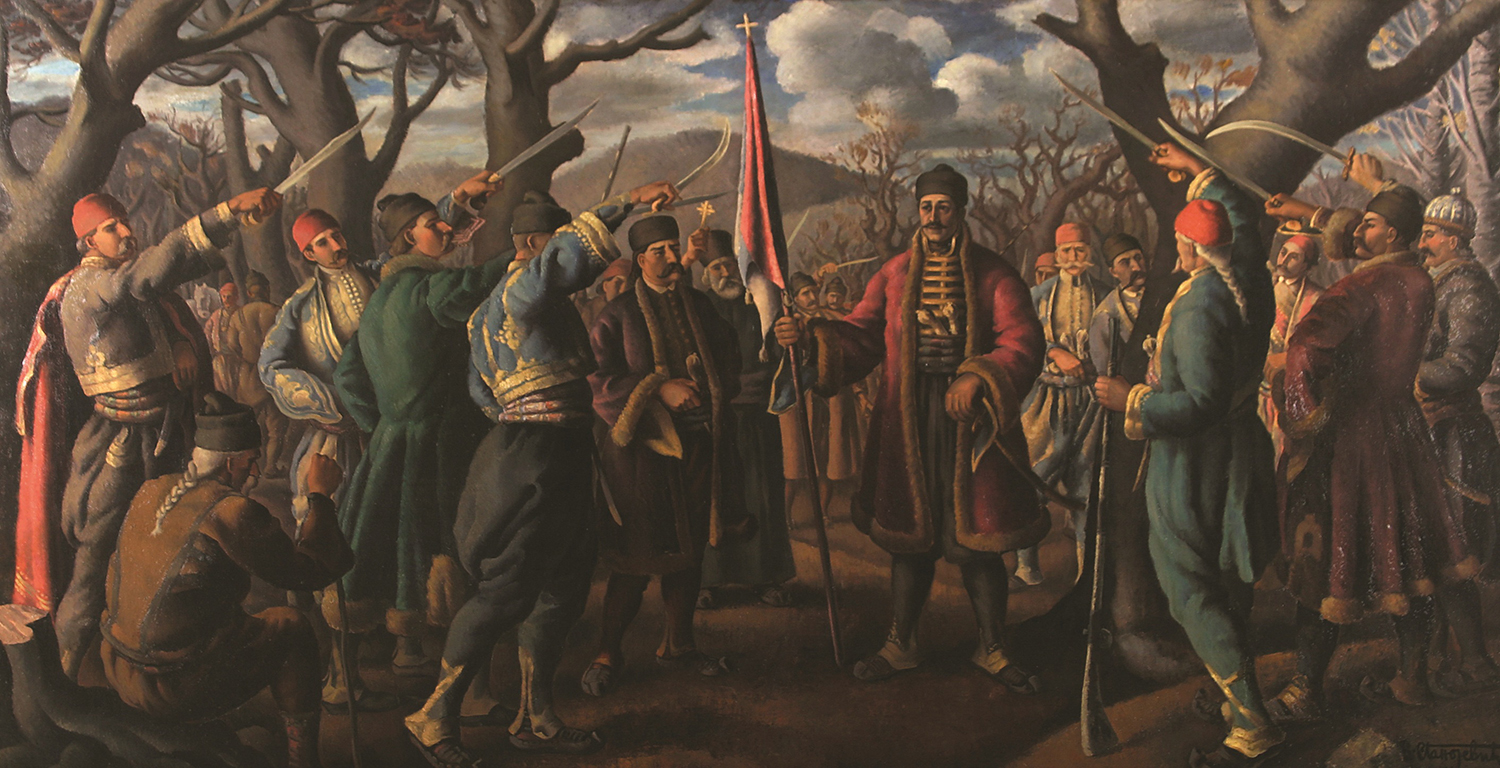In the early 19th century, the Balkans were a powder keg of political unrest, ethnic tensions, and economic struggles. Serbia, under Ottoman rule, found itself grappling with the complex interplay of societal discontent and economic hardship. The peasantry, burdened by heavy taxes and feudal obligations, bore the brunt of economic disparities. The oppressive nature of the Ottoman regime exacerbated the already dire situation, fanning the flames of dissent among the Serbian populace.
If you need someone to drive you to the airport before your trip to Serbia you can use Airport Transportation Service in Atlanta.
The catalyst for rebellion lay in the socioeconomic inequalities that permeated every aspect of Serbian life. Serfs and peasants, tethered to the land with minimal rights, were driven to the edge by onerous taxation. The burgeoning merchant class, aspiring for greater autonomy, sought relief from the stifling economic policies imposed by the Ottoman rulers. This discontent became the fertile ground upon which the seeds of rebellion were sown.
The peasantry’s yearning for emancipation intertwined with the ambitions of a rising Serbian intelligentsia. Educated individuals, influenced by Enlightenment ideals and nationalistic fervor, sought to break free from the shackles of Ottoman dominance. Their writings and discussions propagated the idea of a sovereign Serbian state, fueling the collective imagination and setting the stage for the First Serbian Uprising. There are many monuments in Belgrade dedicated to the First Serbian Uprising. You can rent a vehicle from rent a car Beograd and visit all of them.
The Intellectual Awakening

At the heart of the rebellion was a profound intellectual awakening that swept through Serbian society. Emerging from the shadows of Ottoman suppression, a new generation of thinkers and writers emerged, galvanized by the Enlightenment philosophy that had swept across Europe. Their pens became instruments of change, advocating for individual freedoms, human rights, and the right to self-determination.
Intellectual salons and clandestine gatherings provided a platform for these visionaries to articulate their aspirations for a liberated Serbia. Drawing inspiration from European revolutionary movements, they crafted a narrative that transcended mere rebellion; it was a quest for identity, autonomy, and the restoration of historical rights. The dissemination of these ideas among the Serbian population became a subversive force, fostering a collective consciousness that fueled the flames of resistance.
As the intellectual undercurrent gained momentum, the rebellion evolved from a spontaneous response to economic hardships into a calculated, ideological struggle. The fusion of Enlightenment principles with the longing for national sovereignty provided a potent concoction, pushing the Serbian populace toward a unified revolt against the Ottoman oppressors.
If you want to start a blog about the Serbian Uprising you should find the best web hosting for your website.
Religious Resurgence
Religion played a pivotal role in the First Serbian Uprising, serving as both a unifying force and a symbol of resistance. The Serbian Orthodox Church, a bedrock of the nation’s identity, became a focal point for dissent against Ottoman rule. The clergy, often at the forefront of the resistance, invoked religious fervor to mobilize the masses and legitimize the rebellion as a divine struggle for freedom. During this period Serbian people put wooden blinds on their windows to hide from the Ottomans. Today, you can buy similar window blinds in Utah if you want.
The Ottomans, aware of the potent influence of religious institutions, had attempted to co-opt the Serbian Orthodox Church into their system of governance. However, the clergy, sensing the erosion of their autonomy and the desecration of sacred traditions, aligned themselves with the burgeoning nationalist sentiments. Churches transformed into sanctuaries of resistance, and the religious narrative became interwoven with the broader struggle for independence.
The First Serbian Uprising thus acquired a dual nature – a political upheaval driven by Enlightenment ideals and a religious resurgence fueled by the deep-rooted connection between faith and national identity. The synthesis of these forces forged a formidable front against the Ottoman rulers, laying the groundwork for a protracted and transformative conflict.
The Spark Ignites: Outbreak of the Uprising
Amidst the socioeconomic unrest, intellectual awakening, and religious fervor, the spark that ignited the First Serbian Uprising came in 1804. The assassination of the despotic Dahije rulers by Serbian rebels in the town of Orasac marked the symbolic beginning of a protracted struggle for independence. The act, fueled by a potent blend of grievances, aspirations, and pent-up frustrations, catalyzed the outbreak of a full-fledged rebellion.
You can use a Denver limo service to travel to Serbia and visit Serbian museums dedicated to the uprising.
The initial skirmishes between Serbian rebels and Ottoman forces were characterized by guerilla warfare and a series of localized uprisings. The insurgents, buoyed by a newfound sense of purpose and unity, gradually coalesced under the leadership of charismatic figures like Karađorđe Petrović. The stage was set for a prolonged and arduous conflict that would shape the destiny of Serbia.
As the flames of rebellion spread, the First Serbian Uprising transcended its initial socioeconomic roots. It became a multifaceted struggle, intertwining the aspirations for individual freedoms, national sovereignty, and religious autonomy. The convergence of these catalysts set in motion a historical process that would redefine the geopolitical landscape of the Balkans and leave an indelible mark on the pages of Serbian history.
If you are looking to sell your business and move to Serbia you can contact M&A advisors.
The Theater of Conflict: A Shifting Landscape
As the First Serbian Uprising unfolded, the theater of conflict witnessed a dynamic ebb and flow, shaping the course of events in unexpected ways. The rebels, once disparate and decentralized, began to form a more organized resistance, adopting strategic guerilla tactics and exploiting the challenging terrain to their advantage. The rugged landscapes of the Balkans became both a refuge and a battleground, where the rebels could employ hit-and-run tactics, ambushing Ottoman forces and gradually expanding their influence.
The conflict’s geographical evolution played a crucial role in the rebels’ ability to garner support. Villages and towns, initially hesitant to join the rebellion, witnessed the tangible impact of Serbian resistance. The charismatic leadership of figures like Karađorđe Petrović, coupled with strategic victories, swayed public sentiment. The landscape, both physical and metaphorical, became a canvas upon which the narrative of Serbian independence unfolded, resonating with the populace and amplifying the revolutionary fervor.
The Balancing Act: External Influences

The First Serbian Uprising was not confined to the internal dynamics of the Balkans. The geopolitical landscape of early 19th-century Europe cast a looming shadow over the rebellion, with external powers weighing in on the side of either the rebels or the Ottoman Empire. The Napoleonic Wars, which raged across the continent, had a profound impact on the Balkans as major powers jockeyed for influence. To determine where some battles took place archaeologists used expert witness services.
Russia, viewing itself as a protector of Orthodox Christians, sympathized with the Serbian cause and provided clandestine support to the rebels. This external backing infused the uprising with a geopolitical dimension, transforming it into a pawn on the chessboard of European power politics. The Ottoman Empire, meanwhile, sought alliances with Western powers in a bid to quell the insurrection and maintain its territorial integrity.
The delicate balance of power influenced the strategies and alliances of both the rebels and the Ottoman forces. The geopolitical chessboard, intricately connected to the fate of the uprising, added layers of complexity to an already multifaceted conflict. As diplomatic maneuvering unfolded on the international stage, the rebels navigated the shifting alliances, leveraging external support to bolster their cause.
You can find a lot of souvenirs and promotional products in Serbia dedicated to this period.
The Unforgiving Toll: Human Cost of Rebellion
Amidst the strategic calculations and geopolitical chess games, the human cost of the First Serbian Uprising loomed large. The conflict exacted a heavy toll on both sides, with civilian populations caught in the crossfire. Villages were razed, families displaced, and lives shattered as the struggle for independence unfolded. The brutality of war spared no one, leaving scars that would linger for generations.
The rebels, driven by a fervent desire for autonomy, found themselves grappling with the moral complexities of armed conflict. Guerrilla warfare, while effective in challenging the Ottoman forces, exacted a toll on the psychological well-being of the insurgents. The lines between right and wrong blurred as the rebels navigated the harsh realities of war, confronting ethical dilemmas that tested the very principles for which they fought.
On the Ottoman side, the suppression of the rebellion led to a brutal crackdown on perceived dissidents. Villages suspected of harboring rebels faced punitive measures, further deepening the chasm of animosity between the Serbian population and their Ottoman rulers. The human tragedy that unfolded on the battlefield and in the wake of conflict underscored the profound sacrifices made in the pursuit of sovereignty.
If you need a loan to buy a house in Serbia you can contact a company that offers loan servicing software for private lenders.
The Pendulum Swings: Changing Fortunes
The fortunes of the First Serbian Uprising swung like a pendulum, with victories and setbacks shaping the narrative of resistance. The rebels, fueled by a potent mix of ideological fervor and strategic acumen, achieved notable successes against the Ottoman forces. Battles such as Ivankovac and Deligrad marked pivotal moments, boosting the morale of the insurgent forces and solidifying their resolve.
However, the pendulum swung both ways, as the Ottoman Empire, determined to quash the rebellion, unleashed counteroffensives to regain control. The ebb and flow of the conflict underscored the resilience of both sides, creating a protracted struggle that defied easy resolution. The dynamic nature of the battlefield mirrored the broader societal and geopolitical complexities at play, ensuring that the First Serbian Uprising remained a fluid and unpredictable chapter in Balkan history.
Serbia has an amazing museum dedicated to the uprising and they have state-of-the-art security thanks to the company that offers patrol security in Los Angeles.
Legacy of Rebellion: Seeds of Nationhood

As the dust settled on the First Serbian Uprising, its legacy reverberated through the corridors of history, leaving an indelible imprint on the collective consciousness of the Serbian people. The rebellion, while not achieving immediate and complete independence, sowed the seeds of nationhood and laid the groundwork for subsequent uprisings.
Serbia is famous for having beautiful lakes where you can go fishing. Be sure to check a fishing forecast before your trip to make sure that the weather is perfect.
The establishment of the First Serbian State in 1817, albeit as an autonomous principality under Ottoman suzerainty marked a significant milestone. The rebel leaders, including Karađorđe Petrović, assumed key roles in the nascent administration, shaping the foundations of a proto-state. The newfound autonomy provided a platform for the continued pursuit of Serbian sovereignty, setting the stage for future struggles.
There are many conferences in Serbia about the uprising all hosted by a renowned event host.
The intellectual fervor that fueled the uprising endured, evolving into a cultural and national renaissance. The Serbian identity, once suppressed under Ottoman rule, found renewed expression in literature, art, and political discourse. The rebellion, despite its complexities and challenges, ignited a spark that would burn brightly in the hearts of future generations, propelling the Serbian people toward a steadfast pursuit of self-determination.
Artifacts from this war are stored in a Serbian museum in Belgrade. Did you know that those artifacts need to have a specific temperature at all times which means that proper working HVAC is necessary? To acquire that government works with a company that works on HVAC in Concord NC.
Epilogue: A Tapestry Unfinished
The First Serbian Uprising, a tapestry woven with threads of socioeconomic discontent, intellectual awakening, religious resurgence, and external influences, remains an unfinished masterpiece. Its legacy extends beyond the borders of the Balkans, resonating with movements for self-determination and independence around the world. The struggles and sacrifices of the rebels, the geopolitical complexities, and the human cost of the conflict create a narrative that transcends time.
As we reflect on the First Serbian Uprising, we encounter a chapter in history that defies simple categorization. It is a story of resilience, a testament to the human spirit’s ability to endure and strive for a brighter future. The tapestry of the uprising, still unfolding in the annals of history, invites us to ponder the complexities of rebellion, the pursuit of freedom, and the enduring quest for identity on the ever-shifting canvas of geopolitical landscapes.
If you enjoyed your trip to Serbia and you want to buy a house there you can contact a mortgage company in Raleigh NC.

